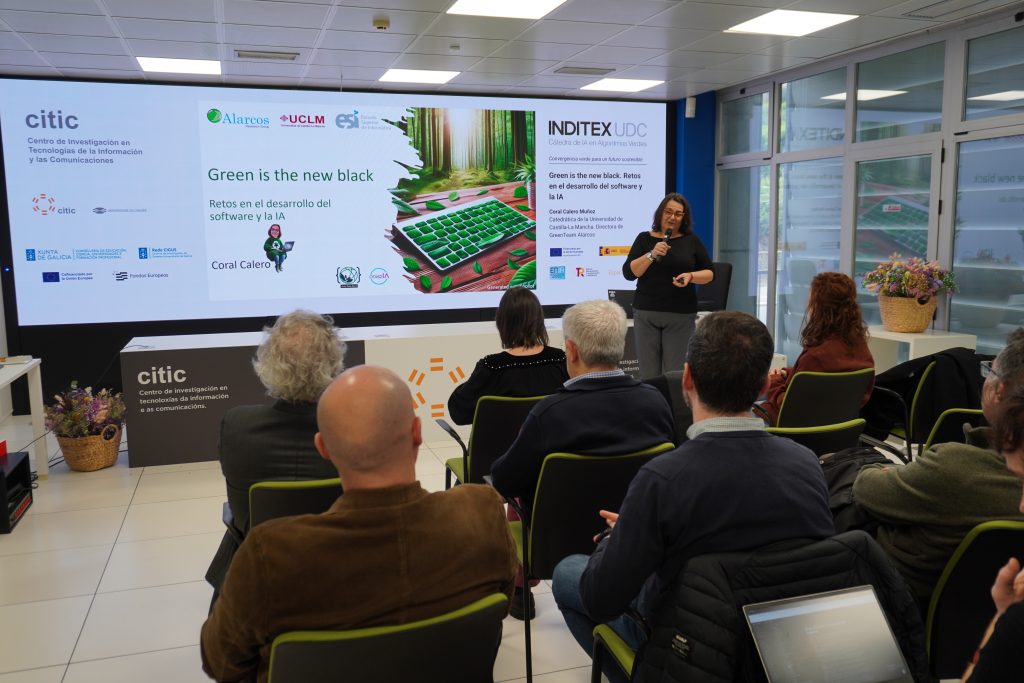
The risks of AI's energy costs under debate at CITIC of UDC
- Coral Calero Muñoz, Professor at the University of Castilla-La Mancha and member of the Spanish Research Ethics Committee, warns about the dangers of high energy costs in ICT and the need to reduce their environmental impact.
- Among other solutions, she advocates for effective energy consumption measurement as a key step toward reduction.
- This talk was part of the lecture series organized by the INDITEX-UDC Chair of AI in Green Algorithms.
A Coruña, March 10, 2025.– Nearly 68% of the global population uses the internet. Annual internet traffic amounts to 100 zettabytes. The CO2 emissions from a single day of Netflix streaming are equivalent to a car circling the Earth 3,248 times. Posting a 15-second reel on Instagram consumes the same amount of energy as uploading eight photos. These were just some of the striking statistics presented by Coral Calero, Professor at the University of Castilla-La Mancha, during her talk at CITIC of UDC, highlighting the sustainability risks associated with ICT’s high energy costs.
“Artificial intelligence is one of the most promising technologies across all sectors and is having a transformative impact in many industries,” stated Coral Calero. In today’s landscape, where AI tools are increasingly used and there is a high global demand for ICT solutions from non-tech companies, tech firms are investing millions of dollars to develop AI products and services that meet these needs.
This scenario results in significant energy and resource consumption. Calero illustrated this by discussing the costs of training large-scale language models such as GPT-3 or Bloom, one of the largest language models. “We’re not just talking about electricity but also water, for example,” she explained”. Data centers use water-based cooling systems that dissipate heat through a recirculation cycle, but this method causes 80% of the water to evaporate, accumulating salts and minerals that can damage the system”.
Measuring to Control
Ensuring that software is truly energy-efficient requires the ability to measure its impact. By knowing how much energy and resources are needed to train an AI tool, developers can optimize its design and contribute to environmentally friendly technology. In this regard, software sustainability has become a crucial aspect of responsible and efficient development. However, Calero emphasized the importance of distinguishing between software sustainability and green software, as the latter represents only a fraction of the broader sustainability concept.
As Calero explained in her talk, software sustainability encompasses three fundamental dimensions that must be considered when designing new applications: economic, social, and environmental. The environmental dimension is what is known as green software, focusing specifically on reducing the ecological impact of software development and usage.
Measurements can be carried out using two different approaches. Through estimation software, applications installed on the computer that provide an estimate of energy consumption; or through hardware meters, external devices connected to the computer that record real data on energy consumption.
According to Coral Calero, her research group is developing a measurement method called the Green Software Measurement Process (GSMP), which consists of multiple phases, including scope definition, measurement environment setup, and final analysis. Beyond scientific research, its goal is to “provide software development companies with practical tips and ideas to make their designs greener.”
Sustainable Research
The INDITEX-UDC Chair of AI in Green Algorithms is one of the 21 ENIA (National Artificial Intelligence Strategy) chairs granted by the Ministry for Digital Transformation and Public Administration. Led by CITIC researcher Verónica Bolón, the chair focuses on developing so-called “green algorithms”, aiming to reduce the environmental impact of software applications while leveraging them to find sustainable solutions through research.
The research team comprises 20 members, 16 of whom are affiliated with the Research Center for Information and Communication Technologies (CITIC) at UDC.
About CITIC
CITIC is a research center that promotes progress and excellence in R&D&I applied to ICT, created in 2008 by the Universidade da Coruña. The center’s scientific activity is structured into four main research areas: Artificial Intelligence; Data Science and Engineering; High-Performance Computing; and Smart Services and Networks, along with a cross-cutting research area: Cybersecurity.
CITIC is accredited as a Center of Excellence and a member of the CIGUS Network for the 2024-2027 period. The accreditation, structuring, and improvement of CITIC are co-financed by the Xunta de Galicia and 60% by the European Union under the FEDER Galicia 2021-2027 Operational Program, with the thematic objective of promoting “a smarter Europe: innovative economic transformation” (ED431G 2023/01).





